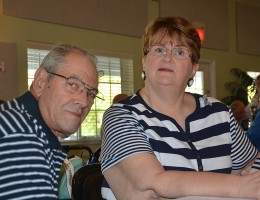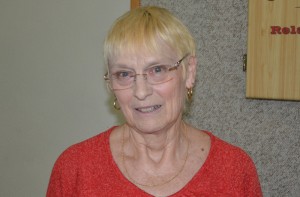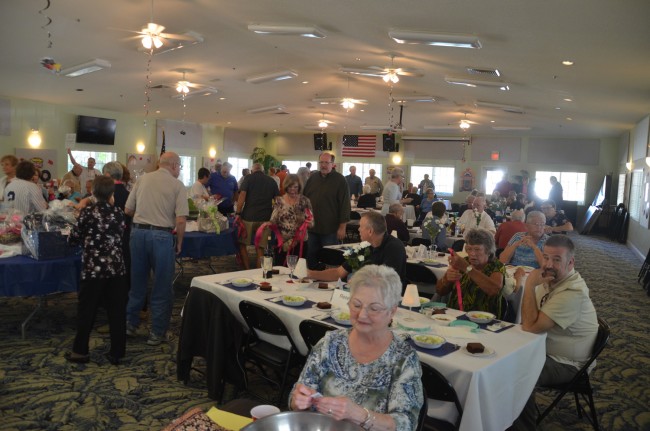
If you drive around Plantation Oaks, the gated community off Old Kings Road south of State Road 100, you might notice dark-blue and white ribbons tied to lampposts. If you notice one, you’ll notice another, and then many more. On some streets—on Ashbury Drive, on Tobias Lane—almost every lamppost is riboned. If you had the ability to pull back à-la-Google Earth and take a more global view of the country, with zooming capabilities for the occasion, you might notice similar ribbons attached to lampposts or trees or mailboxes in other states. In every state. And so far, in England and Canada, too.
The blue-and-white ribbon movement started here, at Plantation Oaks. It is to bring awareness to ALS, the degenerative disease also known as Lou Gehrig’s disease that, with Alzheimer’s and Parkinson’s, is among the cruelest afflictions anyone can suffer, and possibly the cruelest: as ALS progresses (the acronym stands for words that sound themselves hopelessly diseased, amyotrophic lateral sclerosis) the muscles fail, the body shuts down, paralysis sets in from top to bottom, robbing its victim of the power of speech, breathing, eating, drinking, swallowing: all powers, except that of the vital senses. The person imprisoned within can still see, hear, smell. And feel.
Ask Mary Ann Dominessy Reese. She is 62. She started the blue-and-white ribbon campaign from her home in Plantation oaks.
She started it after she was diagnosed, two days before last Christmas, with ALS.
“I had researched my symptoms online, and I was pretty certain that was going to be the diagnosis,” Mary Ann says. “So I had cried a lot. A lot, before the diagnosis. It is a horrible way to die, and that’s what’s going to happen. It’s awful. “
The disease is awful, and Mary Ann never hides the reality of her coming death. There’s no sugar-coating when you hear her speak, as she labors to speak, no self-pity. But there is what visitors to the clubhouse at Plantation oaks last Saturday—those visitors who might have skipped Wings Over Flagler for a special event at the community—would have seen: a $10-a-ticket fund-raiser dinner that drew 120 people, all organized by Mary Ann and a committee of 15 of her neighbors.

And there is the blue-and-white ribbon campaign, which is not abating event though it’s spread to the 50 states. (Blue and white, because Lou Gehrig was a Yankee.)
“I cannot sit around and wait to die,” she said Saturday, even then as she worked at one thing or another. “That’s too depressing. So I’m going to live every day God gives me as best I can. Right now my legs are bad. I have a brace on my left leg, and I have to use a walker. My motor skills are bad, and my voice gets worse every day. I know the time is coming where I’ll be in a wheelchair all the time, and I won’t be able to speak. I don’t know how that’s going to be. Beyond horrible. But in the meanwhile, I am enjoying my family. I’m spending time with my friends. We’ve got a family cruise with my son and grandson in May. I’m really looking forward to it. All you can do is live the best you can, one day at a time. That’s all. I could stay home and cry every day, but it wouldn’t change anything. So I choose not to do that. I have my moments. I cry like everybody. But they are just moments. And they pass.”
All but a handful of tickets to Saturday’s fund-raiser sold within hours of the moment they went on sale, though Mary Ann had raised $2,000 even before the first ticket had sold. The clubhouse Saturday, a space large enough for a ballroom and then some, was full. Olive Garden had donated the salads, Fisherman’s Net, the Flagler Beach restaurant, donated a $50 gift certificate for the raffle. There were loads of gift baskets for the 50-50. (All proceeds go to Project ALS, the non-profit organization.)
“She is a beautiful person,” Diane Gullman, who was taking tickets at the door, said of her friend, whom she’s known five years. “A heart of gold, she would do anything for you that she could possibly do. Of course that was before she was diagnosed with ALS.”
A retired teacher who moved to Flagler Beach with her husband Ed in 2008 from a Pennsylvania town called North East, Mary Ann started noticing something was amiss 14 months ago. She was falling a lot. She thought it was age. She went to a chiropractor. It was the first stop in a long journey of diagnostic dead ends. The chiropractor would manipulate this and that. She’d think she’d be better for a few days, but she wasn’t. An ENT doctor said she had a reflux condition that had nothing to do with ALS. She was treated for that until July, when she had a scary fall in the yard. “No one was around to help me, my husband was gone, my neighbors were gone and I was really afraid, but I finally managed to get up and get back in the house,” she says.
After that came a stint at physical therapy, where again she was given false hope, her falls ascribed to a pelvis allegedly out of alignment. There were more months of that, and of more falling. She then went to a neurologist. There were X-rays, MRIs, then a referral to the Mayo Clinic for more tests.
“Two days before Christmas, they told me it was ALS,” Mary Ann says. It was a death sentence: two to five years.
Through those months Mary Ann watched as the ice-bucket challenge swept the nation, raising upward of $115 million just last year for the ALS Association. But the awareness campaign has faded. There’s no cure. And 5,600 people a year are diagnosed with the disease in the country.
Mary Ann had no trouble drafting her neighbors in her campaign, among them Tina Jeffe, who reflects the anguish that accompanies the disease, not just for those afflicted by it, but for those who love and surround its victims.

The words echo Mary Ann’s, just as the two women’s attitude reverberates with the same conviction. “She’s insisted on the fact that she’s going to get the word out, that this is about this awful disease and how people need to be made aware of it, and that we have to start doing something to get our medical community and congress people to know they need to help,” Jeffe says of Mry Ann’s awareness campaign. “There needs to be some stuff done, because it really is one of the left-out diseases.”
Half-way through Saturday’s dinner, Kevin Gallagher, who emceed the evening, introduced Mary Ann, who thanked the assembly and spoke of her recent experiences. Gallagher then spoke of the disease almost as a clinician, as if wanting to make its brutality clear. He described its mercilessness, its indifference to souls caught within its grip, and its inevitable conclusion. “Not a pretty picture,” Gallagher concluded, “But we aren’t here to paint a pretty picture. We’re here to talk facts.”
ALS facts are nasty and brutish. But then there’s Ed Reese. He’s been married to Mary Ann 15 years. To those married to a person with a disease like ALS, or Alzheimer’s, or Parkinson’s, the disease becomes a way of life, such as life can be at those stages. A way of life when life as most of us know it becomes a relative term.
“It is what it is. I can’t fix it. So we’ll deal with it. And I’ll do whatever I can do until I’m not able to,” Ed says. When he gets frustrated or angry at the inevitability of things, he goes to the gun range. “And I volunteer for the county, although that’s pretty restricted now.” He has coping mechanisms, too. He’s a member of a care-giver group on line. “Every time I start feeling sorry for myself I think of what families are going through, because this disease usually strikes at an earlier age, and there are caregivers, largely women but still many men, caring for their spouse and their children.”
He describes the disease’s symptoms in their progressive malignity. “The only thing I do is not think about it, and I handle each issue as it happens, which is unlike me because I’m retired from the military and some civilian jobs, all of them required a great deal of planning and looking ahead, and I just don’t anymore. I just handle what happens when it happens.”
At the end of the brief interview as Gallagher was beginning to speak, Ed gets up then retracts his steps, bends down to a reporter’s ear, as if to tell a secret, and says of Mary Ann: ““She is the most courageous person I have ever met, and I’m retired from the military.”
He had surely read what Mary Ann had written on March 27, words she seems to have been speaking one way or another since her diagnosis, words, more pointedly, she’s been living since then, to remarkable effect on those who know her and perhaps on herself as well: “I may not be able to beat ALS and a cure might not come in time to save me, but I will go down fighting.”
![]()
Mary Ann Dominessy Reese’s awareness campaign and donations benefit Project ALS Her Facebook blog, In tghe Fight With MADR, can be accessed here, by invitation.





























gb says
This wretched, damnable disease, killed my sister in 2011, she was in her 50’s. She was a nurse her whole life, always helping others, in the end, she could not help herself even move. It scarred me deeply.
A cure must be found….my thoughts and prayers go out to Mary Ann and her family. It puts my stupid little problems in perspective.
cory meron says
My first ALS symptom occurred in 2016, but was diagnosed in 2018. I had severe symptoms ranging from shortness of breath, balance problems, couldn’t walk without a walker or a power chair, i had difficulty swallowing and fatigue. I was given medications which helped but only for a short burst of time, then I decided to try alternative measures and began on ALS Formula treatment from Aknni herbs centre, It has made a tremendous difference for me (Visit ww w. aknniherbscentre.c om). I had improved walking balance, increased appetite, muscle strength, improved eyesight and others.
Carol Fisher says
So sad to read this. My sister’s fiance was diagnosed with this horrible disease when he was just 23 years old. It was a slow 5 year decline and eventual death of what had once been a very athletic,comedic, loving young man. Prayers to Mary and her family.
m&m says
gb. Bless you for your comments. There are no stupid little problem. If they go unattended they become huge problems.
Anonymous says
I lost my Mom 11 years ago and my Grandma (her Mom) 20 years ago to this terrible disease. I am still fighting to find a cure so no one else has to go through this disease.
Anonymous says
My mother died at 48 of ALS. Only 10 months after her official diagnosis. A took a leave from my job to help care for her for the last few months of her life. I feel compassion for anyone with this nasty disease. The good news is Heaven awaits for those who believe and except Christ!
Mary Ann Dominessy Reese says
Thank you for the wonderful article re. my fight with ALS, Pierre. Just a reminder – To increase awareness of ALS, I started a campaign called. “Wrap Up ALS”. I mail out 1 yd. sections of ribbon in the assigned awareness color for ALS to anyone who wants one to put on a door or lamppost or in a window. So far I have sent hundreds to 48/50 states (still need Rhode Island and Wyoming), several in Canada and even one in England. If you or anyone you know would like a ribbon, just email me the name and address to [email protected] and I’ll get one right out to you. There is NO charge!! It’s all about spreading the word that the ice bucket challenge, though a very good thing, did not bring us a cure or even any viable treatment – a diagnosis is still a death sentence. We need to destroy this monster!!!!
Mike Hull says
I’m about to have my 54th and finale birthday……….ALS is a monster and leaves no survivors and no hope. Our brain will remain fully functioning while our bodies slowly shut down. Sad way to die.
Mike
Amy Larder says
My husband who had been diagnosed with Bulbar ALS disease for 2 years at the age of 63 had all his symptoms reversed with Ayurveda medicine from naturalherbscentre after undergoing their ALS/MND natural protocol, he no longer requires a feeding tube. God Bless all Lou Gehrig’s disease Caregivers. Stay Strong, take small moments throughout the day to thank yourself, to love your self, and pray to whatever faith, star, spiritual force you believe in and ask for strength. I can personally vouch for these remedy but you would probably need to decide what works best for you.